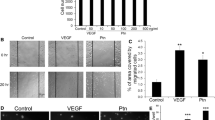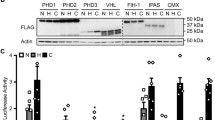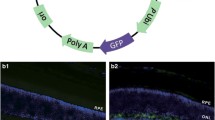Abstract
Ocular neovascularization is a defining feature of several blinding diseases. We have previously described the effectiveness of long-term pigment epithelium-derived factor (PEDF) expression in the retina of diabetic mice in ameliorating some diabetic retinopathy hallmarks. In this study, we aimed to investigate if the antiangiogenic potential of PEDF overexpression was enhanced in combination with placental growth factor (PlGF) silencing. Human RPE cells were transfected with a self-replicating episomal vector (pEPito) for PEDF overexpression and/or a siRNA targeting PlGF gene. Conditioned media from PEDF overexpression, from PlGF inhibition and from their combination thereof were used to culture human umbilical vein endothelial cells, and their proliferation rate, migration capacity, apoptosis and ability to form tube-like structures were analyzed in vitro. We here demonstrate that pEPito-driven PEDF overexpression in combination with PlGF silencing in RPE cells does not affect their viability and results in an enhanced antiangiogenic activity in vitro. We observed a significant decrease in the migration and proliferation of endothelial cells, and an increase in apoptosis induction as well as a significant inhibitory effect on tube formation. Our findings demonstrate that simultaneous PEDF overexpression and PlGF silencing strongly impairs angiogenesis compared with the single approaches, providing a rationale for combining these therapies as a new treatment for retinal neovascularization.







Similar content being viewed by others

References
Campochiaro PA (2013) Ocular neovascularization. J Mol Med 91:311–321. https://doi.org/10.1007/s00109-013-0993-5
Gariano RF, Gardner TW (2005) Retinal angiogenesis in development and disease. Nature 438:960–966. https://doi.org/10.1038/nature04482
Osaadon P, Fagan XJ, Lifshitz T, Levy J (2014) A review of anti-VEGF agents for proliferative diabetic retinopathy. Eye 28:510–520. https://doi.org/10.1038/eye.2014.13
Rizzo S, Genovesi-Ebert F, Di Bartolo E et al (2008) Injection of intravitreal bevacizumab (Avastin) as a preoperative adjunct before vitrectomy surgery in the treatment of severe proliferative diabetic retinopathy (PDR). Graefes Arch Clin Exp Ophthalmol 246:837–842. https://doi.org/10.1007/s00417-008-0774-y
Xu J, Li Y, Hong J (2014) Progress of anti-vascular endothelial growth factor therapy for ocular neovascular disease: benefits and challenges. Chin Med J (Engl) 127:1550–1557
Mintz-Hittner HA, Kuffel RRJ (2008) Intravitreal injection of bevacizumab (avastin) for treatment of stage 3 retinopathy of prematurity in zone I or posterior zone II. Retina 28:831–838. https://doi.org/10.1097/IAE.0b013e318177f934
Amadio M, Govoni S, Pascale A (2016) Targeting VEGF in eye neovascularization: What’s new? A comprehensive review on current therapies and oligonucleotide-based interventions under development. Pharmacol Res 103:253–269. https://doi.org/10.1016/j.phrs.2015.11.027
Wu L, Martinez-Castellanos MA, Quiroz-Mercado H et al (2008) Twelve-month safety of intravitreal injections of bevacizumab (Avastin): results of the Pan-American Collaborative Retina Study Group (PACORES). Graefe’s Arch Clin Exp Ophthalmol 246:81–87. https://doi.org/10.1007/s00417-007-0660-z
Jardeleza MSR, Miller JW (2009) Review of anti-VEGF therapy in proliferative diabetic retinopathy. Semin Ophthalmol 24:87–92. https://doi.org/10.1080/08820530902800330
Nguyen QD, De Falco S, Behar-Cohen F et al (2018) Placental growth factor and its potential role in diabetic retinopathy and other ocular neovascular diseases. Acta Ophthalmol 96:1–9. https://doi.org/10.1111/aos.13325
Carmeliet P (2001) Synergism between vascular endothelial growth factor and placental growth factor contributes to angiogenesis and plasma extravasation in pathological conditions. Nat Med 7:575–583. https://doi.org/10.1038/87904
Spirin KS, Saghizadeh M, Lewin SL et al (1999) Basement membrane and growth factor gene expression in normal and diabetic human retinas. Curr Eye Res 18:490–499. https://doi.org/10.1076/ceyr.18.6.490.5267
Khaliq A, Foreman D, Ahmed A et al (1998) Increased expression of placenta growth factor in proliferative diabetic retinopathy. Lab Invest 78:109–116
Yamashita H, Eguchi S, Watanabe K et al (1999) Expression of placenta growth factor (PIGF) in ischaemic retinal diseases. Eye 13:372–374. https://doi.org/10.1016/0014-4835(91)90248-d
Kowalczuk L, Touchard E, Omri S et al (2011) Placental growth factor contributes to micro-vascular abnormalization and blood-retinal barrier breakdown in diabetic retinopathy. PLoS ONE. https://doi.org/10.1371/journal.pone.0017462
Yonekura H, Sakurai S, Liu X et al (1999) Placenta growth factor and vascular endothelial growth factor B and C expression in microvascular endothelial cells and pericytes. Implication in autocrine and paracrine regulation of angiogenesis. J Biol Chem 274:35172–35178. https://doi.org/10.1074/jbc.274.49.35172
Ando R, Noda K, Namba S et al (2014) Aqueous humour levels of placental growth factor in diabetic retinopathy. Acta Ophthalmol. 92:245–246. https://doi.org/10.1111/aos.12251
Jonas JB, Jonas RA, Neumaier M, Findeisen P (2012) Cytokine concentration in aqueous humor of eyes with diabetic macular edema. Retina 32:2150–2157. https://doi.org/10.1097/IAE.0b013e3182576d07
Kovacs K, Marra KV, Yu G et al (2015) Angiogenic and inflammatory vitreous biomarkers associated with increasing levels of retinal ischemia. Invest Ophthalmol Vis Sci 56:6523–6530. https://doi.org/10.1167/iovs.15-16793
Huang H, He J, Johnson DK et al (2015) Deletion of placental growth factor prevents diabetic retinopathy and is associated with Akt activation and HIF1 a -VEGF pathway inhibition. Diabetes 64:200–212. https://doi.org/10.2337/db14-0016
Dawson DW, Volpert OVV, Gillis P et al (1999) Pigment epithelium-derived factor: a potent inhibitor of angiogenesis. Science 285(80):245–248. https://doi.org/10.1126/science.285.5425.245
King GL, Suzuma K (2000) Pigment-epithelium-derived factor-a key coordinator of retinal neuronal and vascular functions. N Engl J Med 342:349–351. https://doi.org/10.1056/NEJM200002033420511
Ohno-Matsui K, Morita I, Tombran-Tink J et al (2001) Novel mechanism for age-related macular degeneration: an equilibrium shift between the angiogenesis factors VEGF and PEDF. J Cell Physiol 189:323–333. https://doi.org/10.1002/jcp.10026
Ogata N, Nishikawa M, Nishimura T et al (2002) Unbalanced vitreous levels of pigment epithelium-derived factor and vascular endothelial growth factor in diabetic retinopathy. Am J Ophthalmol 134:348–353. https://doi.org/10.1016/s0002-9394(02)01568-4
Calado SM, Diaz-Corrales F, Silva GA (2016) pEPito-driven PEDF expression ameliorates diabetic retinopathy hallmarks. Hum Gene Ther Methods 27:79–86. https://doi.org/10.1089/hgtb.2015.169
Araujo RS, Santos DF, Silva GA (2018) The role of the retinal pigment epithelium and Muller cells secretome in neovascular retinal pathologies. Biochimie 155:104–108. https://doi.org/10.1016/j.biochi.2018.06.019
Davis AA, Bernstein PS, Bok D et al (1995) A human retinal pigment epithelial cell line that retains epithelial characteristics after prolonged culture. Invest Ophthalmol Vis Sci 36:955–964
Akrami H, Soheili Z-S, Sadeghizadeh M et al (2011) PlGF gene knockdown in human retinal pigment epithelial cells. Graefe’s Arch Clin Exp Ophthalmol 249:537–546. https://doi.org/10.1007/s00417-010-1567-7
Bradley J, Ju ÆM, Robinson ÆGS (2007) Combination therapy for the treatment of ocular neovascularization. Angiogenesis 10:141–148. https://doi.org/10.1007/s10456-007-9069-x
Hombrebueno JR, Ali IHA, Xu H, Chen M (2015) Sustained intraocular VEGF neutralization results in retinal neurodegeneration in the Ins2 Akita diabetic mouse. Sci Rep 5:18316. https://doi.org/10.1038/srep18316
Park HL, Kim JH, Park CK (2014) Neuronal cell death in the inner retina and the influence of vascular endothelial growth factor inhibition in a diabetic rat model. Am J Pathol 184:1–11. https://doi.org/10.1016/j.ajpath.2014.02.016
Storkebaum E, Lambrechts D, Carmeliet P (2004) VEGF: once regarded as a specific angiogenic factor, now implicated in neuroprotection. BioEssays 26:943–954. https://doi.org/10.1002/bies.20092
Araujo RS, Silva MS, Santos DF, Silva GA (2020) Dysregulation of trophic factors contributes to diabetic retinopathy in the Ins2(Akita) mouse. Exp Eye Res 194:108027. https://doi.org/10.1016/j.exer.2020.108027
Huo X, Li Y, Jiang Y et al (2015) Inhibition of ocular neovascularization by co-inhibition of VEGF-A and PLGF. Cell Physiol Biochem 35:1787–1796. https://doi.org/10.1159/000373990
Rakic J, Lambert V, Devy L et al (2003) Placental growth factor, a member of the VEGF Family, contributes to the development of choroidal neovascularization. Invest Ophthalmol Vis Sci 44:3186–3193. https://doi.org/10.1167/iovs.02-1092
Tombran-Tink J, Chader GG, Johnson LV (1991) PEDF: a pigment epithelium-derived factor with potent neuronal differentiative activity. Exp Eye Res 53:411–414. https://doi.org/10.1016/0014-4835(91)90248-d
Huang Q, Wang S, Sorenson C, Sheibani N (2008) PEDF-deficient mice exhibit an enhanced rate of retinal vascular expansion and are more sensitive to hyperroxia-mediated vessel obliteration. Exp Eye Res 87:226–241. https://doi.org/10.1016/j.exer.2008.06.003.PEDF-Deficient
Park K, Jin J, Hu Y, Zhou K (2011) Overexpression of pigment epithelium – derived factor inhibits retinal inflammation and neovascularization. Am J Pathol 178:688–698. https://doi.org/10.1016/j.ajpath.2010.10.014
Cayouette M, Smith SB, Becerra SPP, Gravel C (1999) Pigment epithelium-derived factor delays the death of photoreceptors in mouse models of inherited retinal degenerations. Neurobiol Dis 6:523–532. https://doi.org/10.1006/nbdi.1999.0263
Cao W, Tombran-Tink J, Chen W et al (1999) Pigment epithelium-derived factor protects cultured retinal neurons against hydrogen peroxide-induced cell death. J Neurosci Res 57:789–800. https://doi.org/10.1002/(SICI)1097-4547(19990915)57:6%3c789:AID-JNR4%3e3.0.CO;2-M
Streck CJ, Zhang Y, Zhou J et al (2005) Adeno-associated virus vector-mediated delivery of pigment epithelium-derived factor restricts neuroblastoma angiogenesis and growth. J Pediatr Surg 40:236–243. https://doi.org/10.1016/j.jpedsurg.2004.09.049
Haurigot V, Villacampa P, Ribera A et al (2012) Long-term retinal PEDF overexpression prevents neovascularization in a murine adult model of retinopathy. PLoS ONE 7:1–12. https://doi.org/10.1371/journal.pone.0041511
Colella P, Ronzitti G, Mingozzi F (2018) Emerging issues in AAV-mediated in vivo gene therapy. Mol Ther Methods Clin Dev 8:87–104. https://doi.org/10.1016/j.omtm.2017.11.007
Chen Q, Cheng P, Song NA et al (2012) Antitumor activity of placenta-derived mesenchymal stem cells producing pigment epithelium-derived factor in a mouse melanoma model. Oncol Lett 4:413–418. https://doi.org/10.3892/ol.2012.772
Bai Y, Huang L, Xu X et al (2012) Polyethylene glycol-modified pigment epithelial-derived factor : new prospects for treatment of retinal neovascularization. J Pharmacol Exp Ther 342:131–139
Bai Y-J, Huang L-Z, Xu X-L et al (2012) Polyethylene glycol-modified pigment epithelial-derived factor: new prospects for treatment of retinal neovascularization. J Pharmacol Exp Ther 342:131–139. https://doi.org/10.1124/jpet.112.192575
Michalczyk ER, Chen L, Fine D et al (2018) Pigment epithelium-derived factor (PEDF) as a regulator of wound angiogenesis. Sci Rep 8:11142. https://doi.org/10.1038/s41598-018-29465-9
Zhou Y, Tu C, Zhao Y et al (2016) Biochemical and biophysical research communications placental growth factor enhances angiogenesis in human intestinal microvascular endothelial cells via PI3K/Akt pathway : potential implications of in fl ammation bowel disease. Biochem Biophys Res Commun 470:967–974. https://doi.org/10.1016/j.bbrc.2016.01.073
Arezumand R, Mahdian R, Zeinali S (2016) Identification and characterization of a novel nanobody against human placental growth factor to modulate angiogenesis. Mol Immunol 78:183–192. https://doi.org/10.1016/j.molimm.2016.09.012
Acknowledgements
The authors acknowledge the financial support of Fundação para a Ciência e Tecnologia (Grant No. SFRH/BD/114051/2016 individual fellowship to Rute Araújo), Projetos de Investigação Científica e Desenvolvimento Tecnológico (IC&DT), Grant No. 02/SAICT/2017/028121 (to Gabriela A. Silva), and the Marie Curie Reintegration Grant (Grant No. PIRG-GA-2009-249314 to Gabriela A. Silva) under the FP7 program. iNOVA4Health—UID/Multi/04462/2013, a program financially supported by Fundação para a Ciência e Tecnologia / Ministério da Educação e Ciência, through national funds and co-funded by FEDER under the PT2020 Partnership Agreement is also acknowledged.
Author information
Authors and Affiliations
Corresponding author
Ethics declarations
Conflicts of interest
The authors declare that they have no conflict of interest.
Additional information
Publisher's Note
Springer Nature remains neutral with regard to jurisdictional claims in published maps and institutional affiliations.
Rights and permissions
About this article
Cite this article
Araújo, R.S., Silva, G.A. PlGF silencing combined with PEDF overexpression: Modeling RPE secretion as potential therapy for retinal neovascularization. Mol Biol Rep 47, 4413–4425 (2020). https://doi.org/10.1007/s11033-020-05496-2
Received:
Accepted:
Published:
Issue Date:
DOI: https://doi.org/10.1007/s11033-020-05496-2



